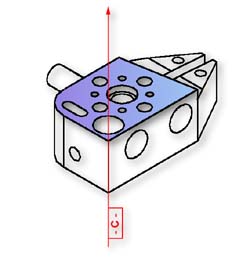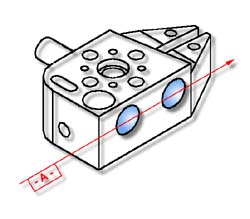Coordinate System Primary Datum
Command Activation:
| j |
PCS→Orient |
 |
| Keyboard |
Main Menu |
Toolbar |
Definition
Orient acts on the last measured or recalled 3D directed feature or pair of
non-directional features which could serve to create a 3D directed feature. Orient sees
through transparent operations such as other PCS formation commands, distance and angles,
etc. Orient establishes the direction of the primary PCS axis, with the selection of X, Y
or Z determined by the MCS X, Y or Z axis to which the directed feature axis most
parallel. Orient will be disabled if feature(s) are not validated as having the
required components to establish a primary datum.
 |
 |
| figure 1, Plane Orient |
figure 2, Orient to Spheres |
The Orient command destroys the axis and origin references of the previous PCS and, if
not already visible, invokes the PCS Setup Guide. For proper function, the Orient must be
followed by the Align command with one exception, after performing the orient command, you
can establish the origin on the characteristics of the feature. An example might be the
measuring of a XY plane, which is used to establish the primary datum through the orient
command along the Z axis, as shown in figure 1. Once the orient has been completed, you
can establish the Z origin on that plane. Another example might be establishing the
primary axis through two spheres, as shown in figure 2.
When the Orient command is activated, Geomet will look at the last feature in the
inspection report to determine whether it has the necessary information to form the
Primary datum, see table 1. Should Geomet determine that the last feature
requires a second feature to solve for a primary datum, then it will continue to look back
in the inspection report until the next feature is found, see table 2. If the
validation tests fail, Geomet will then inform the operator that the orient command has
failed and will abort the operation.
Feature Validation Tables
| |
1D Point |
2D Point |
3D Point |
Circle |
Ellipse |
Line |
Plane |
Sphere |
Cylinder |
Cone* |
| Orient |
|
|
|
|
|
|
X |
|
X |
X |
| table 1, Orient based on a single
feature |
| |
1D Point |
2D Point |
3D Point |
Circle |
Ellipse |
Line |
Plane |
Sphere |
Cylinder |
Cone* |
| 1D Point |
|
|
|
|
|
|
|
|
|
|
| 2D Point |
|
|
|
|
|
|
|
|
|
|
| 3D Point |
|
|
X |
|
|
|
|
X |
|
X |
| Circle |
|
|
|
|
|
|
|
|
|
|
|
Ellipse |
|
|
|
|
|
|
|
|
|
|
| Line |
|
|
|
|
|
|
|
|
|
|
| Plane |
|
|
|
|
|
|
|
|
|
|
| Sphere |
|
|
X |
|
|
|
|
X |
|
X |
| Cylinder |
|
|
|
|
|
|
|
|
|
|
| Cone |
|
|
X |
|
|
|
|
X |
|
X |
|
Cones:
The apex of a cone or the centroid of the diameter along the axis of the cone are treated
similar to a 3D point. |
|
table 2, Orient using 2 feature combinations |
|





